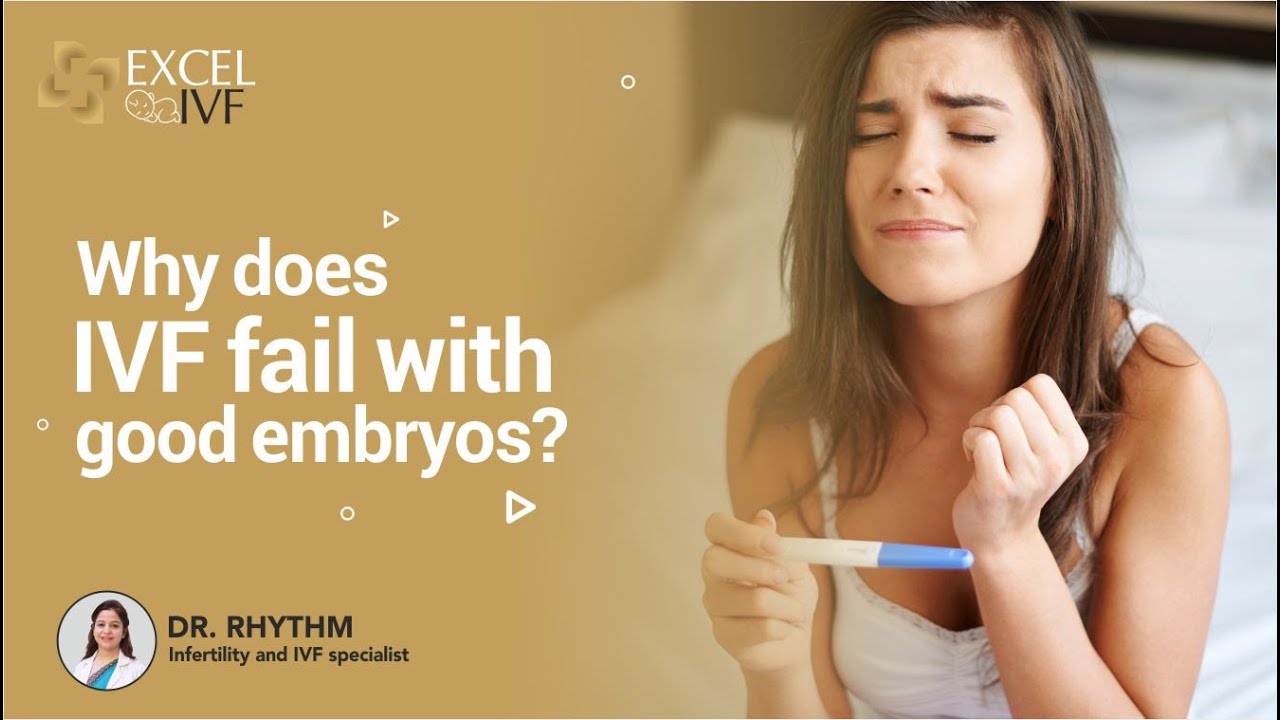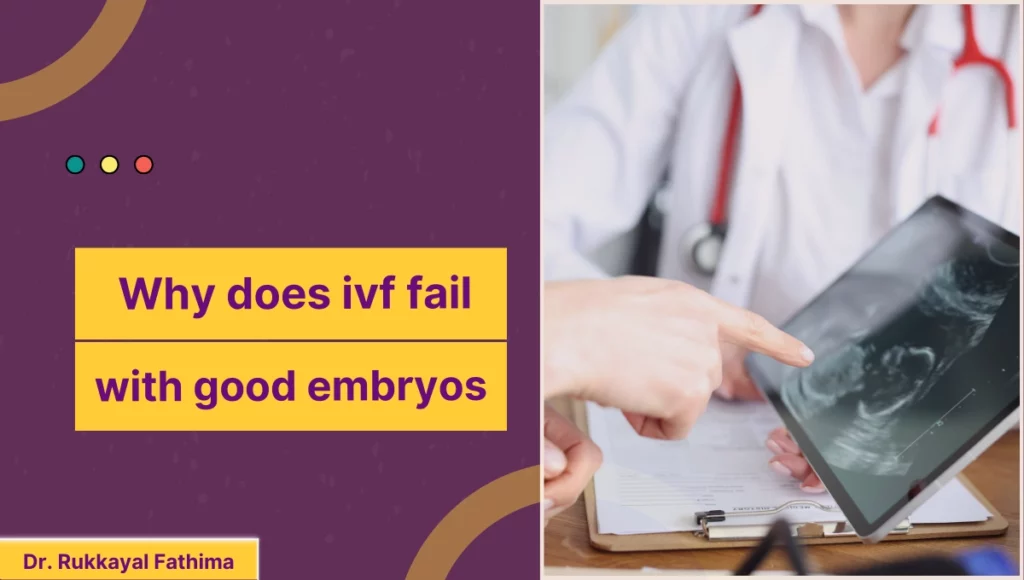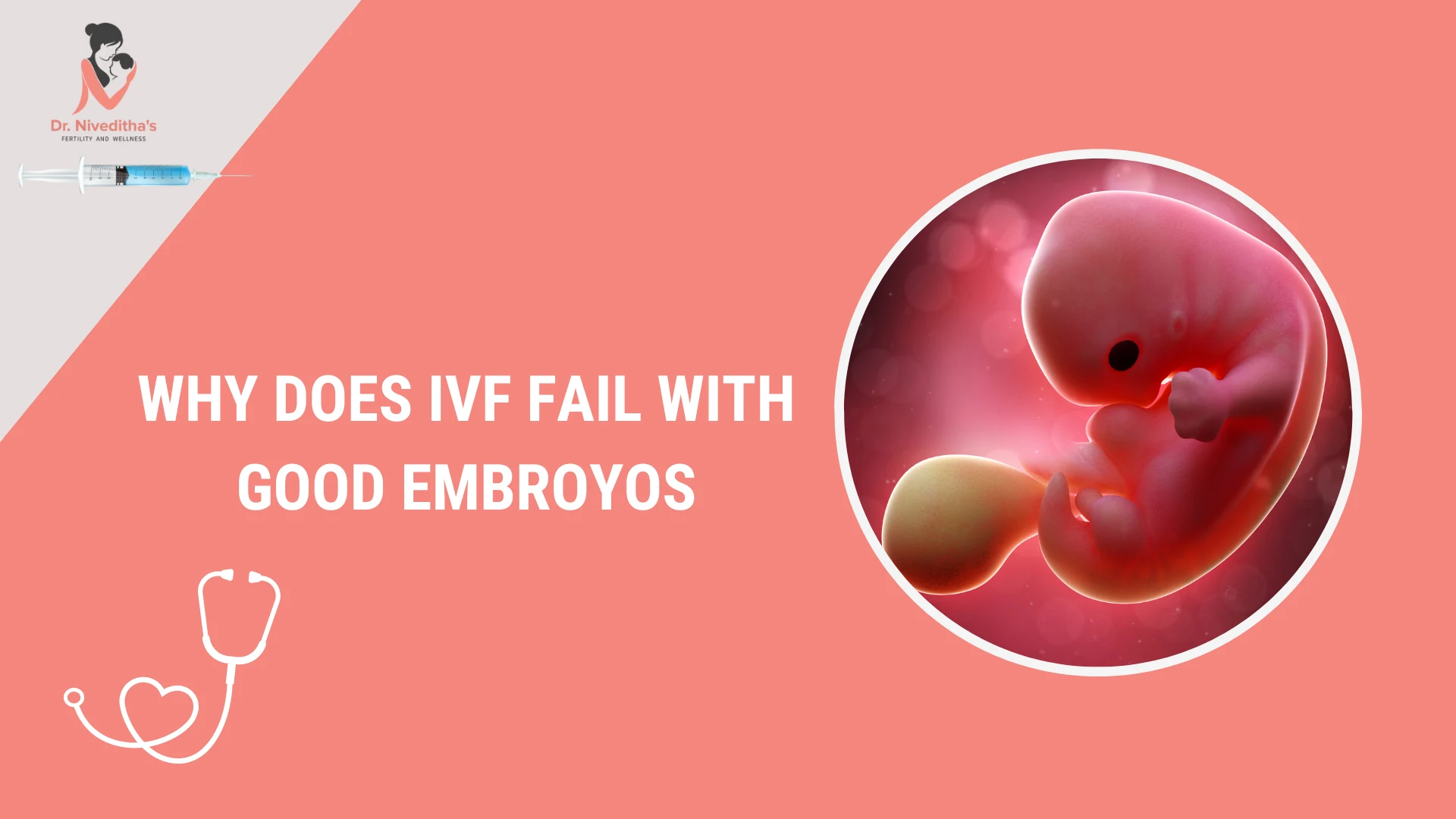Why Does IVF Fail with Good Embryos?
In vitro fertilization (IVF) is a beacon of hope for so many people dreaming of starting a family. You’ve gone through the injections, the egg retrieval, the anxious wait for embryo development—and then you hear the magic words: “Your embryos look great!” It feels like the finish line is in sight. But sometimes, even with those perfect-looking embryos, IVF doesn’t work. The pregnancy test comes back negative, and you’re left wondering, What went wrong? If this sounds familiar, you’re not alone. It’s a question that haunts countless couples and individuals, and the answers aren’t always simple.
The truth is, even “good” embryos—those that look healthy under a microscope—don’t always lead to a baby. Science has come a long way, but IVF isn’t a guaranteed ticket to parenthood. In this deep dive, we’ll explore why IVF can fail even when everything seems perfect on paper. We’ll unpack the science, share real-world insights, and offer practical tips to help you navigate this emotional rollercoaster. Whether you’re in the thick of your IVF journey or just starting to research, this is for you.
The Mystery of “Good” Embryos
When doctors talk about “good” embryos, they’re usually looking at things like shape, cell division, and overall appearance. These embryos get top grades—like an A+ on a school project. But here’s the catch: looks can be deceiving. A beautiful embryo doesn’t always mean it’s ready to grow into a healthy pregnancy. So, what’s going on beneath the surface?
Beyond the Microscope: What Makes an Embryo “Good”?
Embryos are graded based on how they look at certain stages, usually around day 5 or 6 when they become blastocysts—a tiny ball of cells with a fluid-filled center. Doctors check for symmetry, the number of cells, and how much fragmentation (little bits of cell debris) is present. A “good” embryo ticks all these boxes. But here’s what they can’t see without extra testing: the embryo’s genetic makeup, its energy levels, or how well it can communicate with your body once it’s transferred.
Think of it like buying a shiny new car. It might look flawless on the outside, but if the engine’s faulty or the battery’s dead, it’s not going anywhere. Similarly, an embryo might look perfect but still have hidden issues that stop it from implanting or growing.
The Stats Don’t Lie
Even with top-quality embryos, success isn’t guaranteed. According to the Society for Assisted Reproductive Technology (SART), for women under 35 using their own eggs, about 55% of embryo transfers lead to a live birth. That number drops as age goes up—down to around 20% for women 38-40, and just 3% for those over 42. So, even with “good” embryos, there’s a big chunk of transfers that don’t work. Why? Let’s break it down.

The Embryo Itself: Hidden Flaws in Plain Sight
Sometimes, the problem starts with the embryo—even if it looks like a superstar. Here’s what could be going wrong inside those tiny cells.
Chromosomal Chaos
One of the biggest reasons IVF fails is something called aneuploidy—when an embryo has the wrong number of chromosomes. Humans need exactly 46 chromosomes (23 from each parent) for a healthy pregnancy. Too many or too few, and the embryo might not implant or could miscarry early on.
Research from Columbia University in 2022 found that these chromosome mix-ups often happen in the very first cell division after fertilization. The DNA copying process hits a snag—maybe because of a glitch in the egg or sperm—and the result is an embryo that can’t develop properly. Even if it looks great on day 5, these hidden errors can spell trouble.
- Why it matters: About 60% of embryos created through IVF have some chromosomal abnormality, especially as women get older. Preimplantation genetic testing (PGT-A) can screen for this, but it’s not foolproof, and not everyone uses it.
- What you can do: Ask your doctor about PGT-A if you’ve had repeated failures. It’s an extra step (and cost), but it might catch issues that a microscope can’t.
Energy Shortages
Embryos need energy to grow, just like we need coffee to get through Monday mornings. They get this energy from tiny powerhouses inside cells called mitochondria. If the egg that made the embryo had weak or aging mitochondria, the embryo might not have the juice to keep dividing or implant.
A 2023 study from the University of Southern California suggested that mitochondrial health could be a silent factor in IVF success. Embryos from younger eggs tend to have more robust mitochondria, while older eggs might pass on less efficient ones.
- Real-life tip: There’s no magic pill to fix this yet, but some clinics are exploring supplements like CoQ10 to boost mitochondrial health before egg retrieval. Talk to your doctor about whether this could help you.
Self-Correction: A Double-Edged Sword
Here’s something wild: some embryos can fix themselves. A 2021 study from Rockefeller University showed that embryos with chromosome issues early on can sometimes “kick out” the bad cells and keep growing normally. But this doesn’t always work. If too many cells are messed up, or if the fix happens too late, the embryo might still fail.
- What this means for you: Even a “good” embryo might be fighting an uphill battle you can’t see. It’s not your fault—it’s biology playing a tricky game.
The Uterus: Not Always a Welcoming Home
Even the best embryo needs the right environment to thrive. If your uterus isn’t ready, implantation can fail—no matter how perfect the embryo is.
Timing Is Everything
Implantation happens when the embryo and your uterine lining (endometrium) sync up perfectly. This “window of implantation” lasts just a few days each cycle. If the embryo’s transferred too early or too late, it might miss the mark.
A 2024 study from Yale Medicine found that some women have a slightly shifted window—maybe because of hormone levels or past health issues. Standard IVF timing doesn’t always account for this.
- Action step: Ask about an endometrial receptivity analysis (ERA). It’s a test that pinpoints your personal implantation window by checking the endometrium’s gene activity. It’s not cheap, but it could make a difference.
Uterine Health Check
Your uterus might look fine on an ultrasound, but small issues can still trip things up. Things like polyps (little growths), scar tissue from past surgeries, or even chronic inflammation can make it harder for an embryo to stick.
- ✔️ Do this: Get a hysteroscopy—a quick procedure where a tiny camera checks inside your uterus. It’s more detailed than an ultrasound and can spot sneaky problems.
- ❌ Avoid this: Skipping follow-ups after a failed cycle. If something’s off, catching it early could save you heartache later.
The Immune System Wildcard
Your immune system is supposed to protect you, but sometimes it gets overzealous. Some researchers think an overactive immune response might see the embryo as a “foreign invader” and reject it. This idea, called reproductive immunology, is still debated, but it’s gaining traction.
A 2023 review from the American Society for Reproductive Medicine noted that women with autoimmune conditions (like lupus or thyroid issues) might have a higher risk of implantation failure. The science isn’t settled, but it’s worth exploring.
- Try this: If you’ve had multiple failures, ask your doctor about testing for immune markers like natural killer (NK) cells or thyroid antibodies. Treatments like steroids or intralipids are controversial but might be options to discuss.
The Transfer: A Delicate Dance
The embryo’s journey from the lab to your uterus is a big moment—and it’s not as simple as it sounds. A shaky transfer can undo everything.
Placement Precision
Where the embryo lands matters. Too close to the cervix or too deep into the uterus, and it might not implant. A skilled doctor uses ultrasound to guide the catheter, but it’s still a bit of an art form.
- Fun fact: A 2022 study from Stanford found that transfers done by doctors with over 500 procedures under their belt had a 10% higher success rate. Experience counts!
- What to ask: “How many transfers has my doctor done?” Don’t be shy—it’s your future on the line.
The Catheter Conundrum
The tiny tube (catheter) that carries the embryo can sometimes stir up trouble. If it’s not clean, or if it picks up mucus or blood on the way, the embryo might not settle in right.
- ✔️ Pro tip: Some clinics use a “trial transfer” before the real deal to map out the best path. Ask if this is an option for you.
Lifestyle and Stress: The Silent Players
You’ve probably heard that stress doesn’t help fertility. But how much does it really matter? And what about the food you eat or the air you breathe?
Stress and Your Body
When you’re stressed, your body pumps out cortisol—a hormone that can mess with your reproductive system. A 2024 study from Harvard showed that women with higher cortisol levels during IVF had a 15% lower implantation rate, even with good embryos.
- Quick quiz: How stressed are you right now?
- A) Chill as a cucumber
- B) A little on edge
- C) Ready to scream
If you picked B or C, try this: 10 minutes of deep breathing or a short walk daily. It won’t fix everything, but it might calm the storm inside.
Diet and Environment
What you eat and where you live could play a role, too. A 2023 study from the University of California linked low vitamin D levels to poorer IVF outcomes. And exposure to pollutants—like car exhaust or pesticides—might quietly harm embryo quality or uterine health.
- Easy wins:
- Pop a vitamin D supplement (check with your doc first).
- Swap processed snacks for whole foods like nuts or fruit.
- Open a window to clear out indoor air gunk.
The Age Factor: Eggs, Sperm, and Time
Age is the elephant in the room for IVF. It affects eggs, sperm, and how your body handles pregnancy.
Egg Quality Over Time
As women age, egg quality drops. By 35, about 25% of eggs have chromosomal issues; by 40, it’s closer to 90%. Even if those eggs turn into “good” embryos, they might not have the stamina to implant or grow.
- Reality check: If you’re over 38 and struggling, donor eggs could boost your odds. It’s a tough call, but the success rate jumps to over 50% per transfer, no matter your age.
Sperm’s Role
Guys aren’t off the hook. Older sperm (from men over 40) can carry more DNA damage, which might weaken embryos. A 2024 study from Johns Hopkins found that paternal age over 45 lowered IVF success by about 12%, even with good-looking embryos.
- For him: A healthy diet, less alcohol, and no smoking can help sperm stay in top shape.
Uncharted Territory: What We Don’t Fully Know
Science doesn’t have all the answers yet. Here are three areas that don’t get enough attention but could hold the key to your IVF puzzle.
The Embryo-Uterus Chat
Implantation isn’t just about sticking—it’s a conversation. The embryo sends chemical signals to the uterus, and the uterus talks back. If this chat goes off-script, implantation fails. A 2023 study from the University of Oxford hinted that some women might lack the right “receptors” for this dialogue, but we’re years away from a fix.
- What’s next: Researchers are working on tests to measure this crosstalk. Stay tuned—it could be a game-changer.
Frozen vs. Fresh: A New Twist
Most people assume fresh embryo transfers are best, but frozen might have an edge. A 2024 meta-analysis from the Mayo Clinic found that frozen transfers had a 5-10% higher implantation rate for women with good embryos. Why? Freezing gives your body a break from hormone overload, letting the uterus reset.
- Think about it: If fresh transfers keep failing, ask about freezing your next batch. It’s not just a backup plan—it might be your golden ticket.
The Microbiome Connection
Your gut and vaginal microbiome—the trillions of bacteria living in you—might influence IVF. A 2023 pilot study from UCLA found that women with a balanced vaginal microbiome had a 20% higher success rate. Too much of the wrong bacteria could spark inflammation, making the uterus less welcoming.
- Try this: Probiotics might help, but the research is early. For now, avoid douching—it can throw off your natural balance.
What to Do After a Failed Cycle
A negative test is crushing, but it’s not the end. Here’s how to regroup and move forward.
Step 1: Take a Breath
Give yourself permission to feel the disappointment. Cry, vent, binge-watch your favorite show—whatever helps. Then, when you’re ready, talk to your doctor.
Step 2: Dig Into the Details
Ask for a post-cycle review. What did the embryos look like? How was the transfer? Were there any red flags in your labs? Knowledge is power.
- Sample questions:
- “Did my lining look thick enough?”
- “Could we tweak my meds next time?”
- “Should we test for anything new?”
Step 3: Build Your Plan
Based on what you learn, adjust your approach. Maybe it’s a new protocol, a different transfer day, or even a second opinion. Here’s a quick checklist:
- ✔️ Review embryo quality with PGT-A.
- ✔️ Check uterine health with hysteroscopy or ERA.
- ✔️ Tweak lifestyle—less stress, better food.
- ❌ Don’t rush into another cycle without a game plan.

A Little Hope: Stories That Inspire
Sometimes, hearing from others can light the way. Take Sarah, a 36-year-old from Ohio. After three failed transfers with “perfect” embryos, she did an ERA and found her window was off by a day. Her next transfer, timed right, worked—she’s now mom to a 2-year-old. Or Mike and Jen, who switched to frozen transfers after four fresh flops. Their fifth try stuck, and they welcomed twins last year.
These stories aren’t promises, but they’re proof that persistence—and a little detective work—can pay off.

Your Turn: What’s Your Next Move?
IVF failing with good embryos is a tough pill to swallow, but it’s not a dead end. It’s a puzzle, and every piece—embryo health, uterine readiness, transfer technique, even your microbiome—matters. Science is still catching up, but you’ve got tools to keep going.
So, here’s a quick poll to keep you engaged:
What’s your biggest IVF worry right now?
- A) Embryo quality
- B) Uterine issues
- C) Stress and lifestyle
- D) Something else (tell us in your head!)
Whatever it is, you’re not in this alone. Talk to your doctor, lean on your support crew, and keep asking questions. The road might be bumpy, but every step brings you closer to answers—and maybe, just maybe, that baby you’ve been dreaming of.




